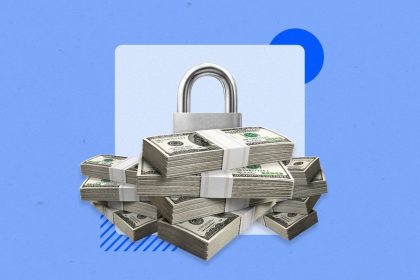Key takeaways
- Monthly maintenance fees for non-interest checking accounts average $5.47, costing you over $65 annually, according to Bankrate’s 2025 Checking Account Survey.
- You can avoid these fees through direct deposit, maintaining minimum balances or switching to a fee-free checking account.
- According to Bankrate data, 47 percent of non-interest checking accounts are completely free, and 95 percent have fees that can be easily waived.
- Compare Bankrate’s best free checking accounts to find an account with no monthly fees and better features.
Some banks charge monthly maintenance fees on their checking accounts, typically ranging from $5 to $15. These fees exist primarily at traditional banks to cover the cost of maintaining your account and providing services like branch access and customer support. Banks waive monthly fees when you meet specific requirements such as maintaining a minimum balance, setting up direct deposit, or using your debit card a certain number of times per month.
The average monthly service fee for a non-interest checking account is $5.47, according to Bankrate’s latest Checking Account and ATM Fee Study. The good news: most monthly fees are completely avoidable if you know the right strategies.
8 ways to avoid monthly checking fees
1. Sign up for direct deposit
One of the easiest ways to circumvent checking account fees is to have your paycheck, pension or Social Security benefit electronically deposited into your account.
Typical requirements:
- Minimum monthly direct deposit amounts range from $250 to $500
- Deposits must be from qualifying sources (employer, government, retirement benefits)
- Some banks only require enrollment, not a specific amount
Peer-to-peer transfers from apps like Venmo or Cash App typically don’t count as direct deposit. The deposit needs to come from an employer, corporation, government entity or retirement benefits administrator. Check out our guide to setting up direct deposit to learn more.
2. Switch to a bank that doesn’t charge monthly fees
A 2025 Bankrate survey found that on average, U.S. consumers stick with the same checking account for 19 years. Americans are loath to leave their banks, and understandably so. Switching banks feels like a hassle — updating direct deposits, automatic bill payments, and getting new debit cards.
But the reality is that the internet has made switching banks much easier. You can open an account online in 10-15 minutes, transfer funds electronically, and update your direct deposit information in a single afternoon. The one-time effort can save you hundreds of dollars over the years.
Beyond avoiding fees, online banks typically offer higher interest rates on checking and savings accounts. Some pay competitive rates that help your money grow while sitting in your account.
3. Meet the minimum balance requirement
If you prefer to stay with your current bank, meeting the minimum balance requirement is often the simplest way to avoid fees. Most banks waive monthly charges if you maintain a certain balance in your checking account.
Common balance requirements:
- $5,000-$20,000 for premium relationship accounts
- $500 minimum daily balance (typical for basic checking)
- $1,500 minimum daily balance (common for interest checking)
ome banks require a minimum daily balance (your balance can never drop below the threshold), while others require an average daily balance (calculated over the month). Make sure you understand which applies to your account.
Keeping $500 or $1,500 in a checking account to avoid a $5-$15 monthly fee makes financial sense. However, if your bank pays little to no interest, that money isn’t growing. You might earn more by switching to a free checking account and putting that balance in a high-yield savings account instead.
4. Open another account at the same bank
Banks reward customers who have multiple accounts with them. This is called relationship banking, and it often comes with perks like waived fees and higher interest rates.
Common relationship benefits:
- Reduced or eliminated overdraft fees
- Waived checking account fees when you have a linked savings account or CD
- Combined balance requirements across all accounts
- Relationship APY bonuses (higher interest rates)
For example, Navy Federal Credit Union waives the $10 monthly fee on its Flagship Checking account if you maintain a $1,500 balance. However, this balance can be spread across multiple accounts — checking, savings, and certificates — making it easier to meet the requirement.
Linking a savings account to your checking account provides overdraft protection. If you accidentally overdraw your checking account, the bank automatically transfers money from savings to cover it, helping you avoid steep overdraft fees.
Some banks also waive checking fees if you have a mortgage with them. This is common at large banks that offer both banking and lending services.
5. Use mobile banking to stay on top of your balance
Many banks now offer mobile banking apps that allow customers to deposit checks, transfer funds and pay bills from their smartphones. This can make managing a checking account more convenient, and it can help you stay on top of your balance by sending you balance alerts, so you can maintain the balance needed to avoid a monthly fee.
Here are nine bank accounts that come with built-in budgeting tools.
There are also third-party personal finance apps that come with helpful digital tools to minimize costs. Many apps are free, but some are not, and costs may escalate if you sign up for premium features or services.
6. Meet the minimum debit card usage requirement
Some banks waive monthly fees if you use your debit card a certain number of times per month. This is typically 10 transactions, though requirements vary by bank.
Banks earn interchange fees from merchants every time you swipe your debit card. These small fees (typically 1-2 percent of the transaction) add up, and banks collect these instead of charging you a monthly service fee.
What counts as a transaction:
- Point-of-sale purchases (swiping at stores)
- Online purchases using your debit card
- Recurring bill payments charged to your debit card
What typically doesn’t count:
- ATM withdrawals
- Transfers between your own accounts
- Balance inquiries
7. Ask for fee forgiveness
Credit card companies usually will forgive a late fee for customers who otherwise have excellent payment records. The same goes for checking account customers. If you are a responsible checking account holder who never overdraws the account, you likely will be forgiven for a rare mistake that triggers an overdraft fee. Try calling the bank’s customer service line or using its online chat service to inquire about getting a fee forgiven.
8. Use ATMs in your bank’s network
While this doesn’t directly avoid monthly maintenance fees, using in-network ATMs saves you from additional fees that add up quickly. Out-of-network ATM fees can cost $3 to $5 per transaction — money that compounds the pain of monthly maintenance fees.
How ATM fees work:
- ATM owner fee: The out-of-network ATM charges you directly
- Your bank’s fee: Your bank charges you for using an out-of-network ATM
- Foreign transaction fees: Additional charges when withdrawing money abroad
Many banks have large ATM networks with thousands of fee-free locations. Before withdrawing cash, use your bank’s mobile app to find nearby in-network ATMs. Some online banks reimburse out-of-network ATM fees up to a certain amount each month.
Which banks charge the highest monthly fees?
Large national banks typically charge higher monthly maintenance fees than regional banks, credit unions or online banks. Here’s a snapshot of major banks and their standard checking account fees:
- Bank of America: $12 per month (Advantage Plus); $25 per month (Advantage Relationship)
- Chase: $12 per month (Total Checking); $25 per month (Premier Plus)
- Wells Fargo: $10 per month (Everyday Checking); $15 per month (Prime Checking)
- Citibank: $12 per month (Basic Banking); $25 per month (Citibank Account)
- U.S. Bank: $6.95 per month (Smartly Checking); $12.95 per month (Gold Checking)
All of these fees can be waived by meeting specific requirements, but if you don’t want to worry about requirements, consider banks that don’t charge monthly fees at all.
Most online banks and many credit unions don’t charge monthly maintenance fees. Ally Bank, Capital One 360, Discover Bank and Marcus by Goldman Sachs are popular options with no monthly fees and no minimum balance requirements.
Bottom line
You don’t have to settle for monthly checking account fees. With thousands of banks and credit unions, there’s a great variety of choices when it comes to where you bank, and many of those choices may have lower or more easily avoidable fees compared to your current account.
Before you open a checking account, look at the bank’s fee schedule. You might find it on the bank’s website, or you might have to call a bank representative to get the link or a copy.
Why we ask for feedback
Your feedback helps us improve our content and services. It takes less than a minute to
complete.
Your responses are anonymous and will only be used for improving our website.
Help us improve our content
Read the full article here
















